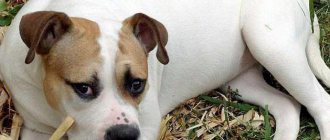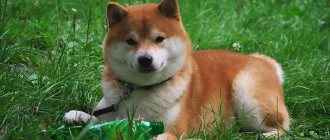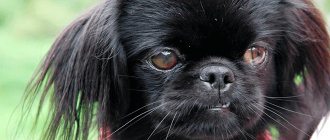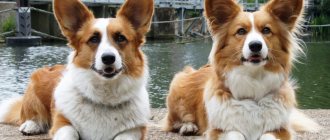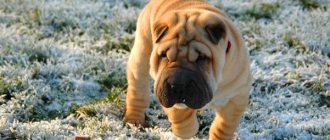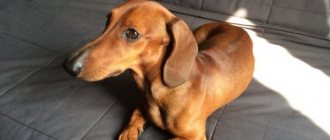The average price for a Great Dane puppy varies from 20,000 to 50,000 rubles or more .
If you are able to afford to spend the amount in the above limit and get a Great Dane puppy, it is worth saying that this is a good choice. But before you bring a magnificent breed into your home, you should think carefully about what your capabilities are in caring for and raising this animal. After all, the Great Dane is a rather unique breed. These are large animals, not capricious like many purebred dogs, they have a soft character, and are friendly in communicating with people.
But even with this characteristic, this breed of dog requires careful care and education, and therefore the future owner must clearly calculate both his physical and material capabilities. And most importantly, before purchasing a puppy, you must clearly set a goal for yourself: why you need a dog . Whether you want to create a show or breeding career for your pet, or simply want to purchase a keeper for your family. First, you should familiarize yourself with the documents regarding the breed you are purchasing. Specifically: familiarize yourself with the Great Dane standard.
History of the Great Dane breed
Great Dane
Today, scientists identify a whole group of large breeds, united by the name “Mastiff Dogs”. In addition to the Great Danes themselves, it includes mastiffs, bulldogs, St. Bernards, Dalmatians, Rottweilers, Newfoundlands, and Leonbergers. It is believed that they all descended from one ancestor - the Tibetan Great Dane. This breed is considered one of the oldest service breeds; the first documentary evidence of its existence dates back to the 12th century BC. Huge, strong dogs have been used for centuries to guard mountain monasteries, hunt large predators and protect herds of nomads. Over time, the breed spread throughout the region. Tibetan dogs were very popular in India, Persia and other Asian countries. There they began to be used as military “weapons” on the fields of military battles, which significantly increased the value of animals. According to Persian law, killing such a dog was a crime even more serious than causing the death of a person, which was reflected in the amount of the fine imposed on the culprit.
Archaeological finds indicate that Tibetan mastiffs took part in numerous campaigns of King Xerxes, including the suppression of uprisings in Egypt and Babylon and the protracted Greek campaign. It is possible that the winners received not only weapons and gold, but also war dogs as trophies. Images of Great Danes are found on coins of Ancient Greece, and in Corinth a monument was even erected to them for their services in the battles with the Peloponnese. Aristotle in his writings paid tribute to the incredible power and natural strength of fighting dogs.
It is not surprising that his pupil and one of the greatest commanders in world history, Alexander the Great, became an ardent admirer of the Molossians (that’s what furry immigrants from Tibet were called in Europe). The Romans also liked the mighty dogs. In peacetime, Great Danes were “kept in shape” by being forced to fight in the ring along with the most dangerous wild animals; during campaigns they invariably accompanied the troops. Together with legionnaires and traders, the animals landed on the British Isles and ended up in the territory of modern Germany, France and Scandinavia.
Images of huge dogs are found on runic stones that have survived to this day, mention of them is found in the Old Icelandic epic, the Elder Edda, and the collection of the Natural History Museum of Denmark boasts seven skeletons of giant hunting dogs that lived between the 5th century BC, found during excavations. . e. and X century AD e.
In a word, the Great Danes had their own Great Migration. And by the 19th century, in different regions of the Old World, several populations of different physiques and colors, but invariably strong and large Molossians, were bred.
The time for large-scale ancient campaigns has passed, different tactics and strategies were used in military conflicts, and with the improvement of weapons, the effectiveness of dogs in battle came to naught. This could have caused the extinction of the breed, but in the Middle Ages other qualities of Great Danes came to the fore.
Great Dane puppy
To participate in big game hunting, they required the stamina and ability of runners. The greatest success here was achieved by English breeders who crossed the “newcomers” with the traditional British “boar dogs”. Thanks to the genes of the English Mastiff and the Irish Wolfhound, representatives of the breed received a more graceful constitution and long legs. Boars, deer and boars simply had no chance against a pack of such athletes. At the same time, the owners of the kennels realized that these giants had a powerful guard instinct, so European nobles and nobles began to actively use Great Danes as personal bodyguards and incorruptible guards.
For a long time there was real confusion in the names. The French Dogue Allemand, the German Englische Docke, the English German boarhound, German Dogge, German Mastiff, as well as Ulmer Dogge, Danische Dogge, Hatzrude, Saupacker, Kammerhunde and other variants of names, in fact, meant the same type of dog, although Because of the difference in phenotype, there was no need to talk about a single breed back then. The Danes were the first to decide to monitor the purity of the blood of their giants; in 1866, the Great Dane standard was approved. Looking ahead, let's say that interest in the undertaking quickly faded, and today only the English version of the name The Great Dane reminds us of this breed.
Only at the end of the 19th century did German dog breeders unite for a common goal: to create, based on motley mastiffs, one breed that would incorporate the best external features and working qualities of animals from different regions. The initiative group first officially met in 1878 in Berlin, and two years later a standard appeared. On January 12, 1888, the National Dog Club of Germany began its work, and soon the first volume of the breed's studbook was published. The nurseries of Mark Hartenstein, Messter, and Karl Farber had the strongest influence on the formation of breeding lines.
In the photo is a Great Dane named Zeus, who is listed in the Guinness Book of Records as the largest dog. His height at the withers is 111.8 cm.
To preserve the purity of color, offspring were allowed to be obtained only in strict combinations, otherwise recessive genes could lead to lightening of the tone or the appearance of unwanted spots. But that was in the first decades of the twentieth century. The Second World War significantly reduced the number of dogs and kennels, so in peacetime the number of individuals and productive lines had to be restored by the whole world.
Today the breed is recognized by leading cynological organizations: the Fédération Cynologique Internationale (FCI), the American Kennel Club (AKC), the Canadian Kennel Club (CAC), the National Kennel Council of Australia (ANKC), and national associations of European states.
The first Great Danes came to Russia even before the revolution. Emperor Alexander II brought two pets from an exhibition in Hamburg, but the breed did not gain immediate popularity. Only in the 70s of the last century in the USSR did they seriously start breeding it. For this purpose, dogs were bought in the countries of the socialist camp - the GDR, Poland, Czechoslovakia. Nowadays nurseries can be found in many large cities.
Origin story
This breed has a rather confused history and origins. It is believed that it appeared on the planet many thousands of years ago, as evidenced by excavations of ancient people and animals, medieval paintings with images of dogs reminiscent of the Great Dane. For the first time, breeding of this breed began in Germany.
Breeders crossed large breeds of dogs in order to obtain a strong and large breed, unlike its predecessors. This is how the Great Dane was bred. Later, they began to add “Danish”, “English”, “hunting” to this name, thereby determining the color and size.
The Great Dane breed was first presented at an exhibition in 1880, where its first standard was approved. Over the years, these animals have become very beloved by people around the world. For example, in the United States this dog is the symbol of one of the districts.
Appearance of a Great Dane
The Great Dane is a giant breed. Sexual dimorphism is pronounced. The height of a dog at the withers should not be lower than 80 cm, of a female – 72 cm. The normal weight of an adult (over 18 months) starts from 54 and 45 kg, respectively. Males look more massive due to the size of the skeleton and “heavier” bones.
The dog gives the impression of a powerful, but proportionally built and even elegant animal. Males have a pronounced square format, females can be a little more elongated.
Head
Great Dane with cropped ears
Long, narrow, with pronounced but not protruding brow ridges. The stop stands out well and is located approximately in the middle between the tip of the nose and the back of the head. The top line of the muzzle and skull are parallel.
Nose
Well developed, wide rather than round. The nostrils are large. The color of the lobe is black (only partial pigmentation is allowed with merle color).
Jaws
Wide, well developed.
Teeth
Strong, healthy. Scissor bite, complete.
Lips
With well defined angles, dark. In merle Great Danes, incomplete pigmentation is allowed.
Eyes
Round in shape, medium in size, with tight-fitting eyelids. As dark as possible, although lighter ones are acceptable in blue and marbled dogs.
Ears
The Great Dane's ears are set high and triangular. In its natural state, hanging, the front part lies close to the cheeks. Docking was necessary when used for hunting, today it is not mandatory and is of a cosmetic nature.
Neck
Long, muscular. Vertical with a slight forward slope. Provides a smooth transition from the top of the body to the head.
Great Dane muzzle
Frame
Great Dane merle color
The Great Dane has a powerful body. The chest is wide, with a well-developed rib cage and mobile ribs. The stomach is tucked. The back is short and elastic. The loin is wide, slightly curved. The croup is wide and muscular, with a slight slope from the rump to the base of the tail.
Tail
The Great Dane's tail is set high. Gradually tapers from the wide base to the tip. When at rest it hangs down freely. When excited, it should not rise significantly above the level of the back.
Legs
Strong, muscular. When viewed from the front, they are completely straight, the rear legs are parallel to the front ones. The front ones with a long sloping shoulder blade form shoulders with well-developed muscles. The hindquarters are strong and well angulated.
Paws
Rounded, vaulted. Nails are short and as dark as possible.
Wool
Very short and dense, shiny and smooth.
Color
Great Danes have recognized fawn (pale gold to deep gold with a black mask), brindle (fawn background with black stripes parallel to the ribs), merle (white with uneven ragged black spots), black and blue colors.
Breed standard
The main standard of the Great Dane breed implies the following characteristics of dogs:
- elongated body shape, proportionally folded;
- elongated muzzle with powerful jaws, high-set triangular ears;
- correctly placed strong limbs;
- tail – medium size and thickness;
- the coat is smooth, colors can be different - from marble to black;
- eyes are almond-shaped.
But different subtypes of this breed may have different standards.
Great Dane Photos
Price
The French Mastiff is a fairly expensive breed. The dog is considered prestigious. There are nurseries in which such animals are bred in almost every capital of the CIS countries, including Moscow and Kyiv.
The minimum price for Dogue de Bordeaux in Russia for 2019 is 25 thousand rubles. But, for such a price you definitely won’t buy a high-breed puppy with a pedigree. To become the owner of a show-class dog that can be registered at exhibitions, you will have to pay twice as much, at least 50 thousand rubles.
Great Dane character
From any Great Dane owner you will hear a lot of compliments about the breed. These giants are naturally very intelligent and friendly. Of course, the puppy loves active games and is prone to mischief, which, given its size, can be destructive. But they are not malicious and do not do nasty things for fun, and if you find yourself on the ground while fighting for a stick, you should not consider such an act a manifestation of hostility - often the “baby” during a period of active growth simply does not realize his size and, as a result, does not measure his strength , which he applies to win in single combat.
Great Dane with his owner
This goes away with age, and an adult dog becomes a sedate and reliable companion. The acutely expressed instinct of a protector and guardian of the weak members of the “pack” turns the Great Dane into more than just a guard - with such a nanny, your child will be completely safe, the dog will never let him be offended.
Don’t be fooled by the external calm and indifferent look that the Great Dane gives to those around him. He constantly “monitors” the situation and controls the situation in order, if necessary, to show whoever encroaches on the life or property of the household who is in charge. At the same time, it usually does not show unmotivated aggression towards random passers-by and neighbors, with the exception of animals with an unstable psyche, disturbed as a result of cruel treatment or improper upbringing.
This sociable and cheerful pet loves spending time with his family most of all. Psychologically, the owner does not tolerate long absences very well, so if your work involves frequent business trips, we advise you to think about a puppy of a different breed.
Great Dane with a cat
Great Dane with children
Description and features
The Dogue de Bordeaux breed has a second, more popular name - French Mastiff. This is a strong and slightly frightening-looking dog, which often appears in films and TV series. Unfortunately, its reputation leaves much to be desired.
In cinema, the dog is often shown as a negative character, evil and treacherous. But this image is completely out of character for him. The French Mastiff is the cutest creature on earth!
If we talk about the animal’s temperament, then it is phlegmatic. It is quite silent, reserved and cold-blooded. However, in some situations, it can behave like a choleric person, barking loudly, being aggressive and moving jerkily. But this only happens in case of a real threat.
Interesting ! Biologists and animal psychologists say that benign aggression is common among some mammals, including dogs. Previously it was believed that it was unique to humans. This concept implies the aggravation of a defense mechanism in order to preserve oneself and one's fellow humans.
The Dogue de Bordeaux is an excellent watchdog. He is alert, careful, attentive and focused. Even if the dog is relaxed, he does not stop carefully observing the territory. He lies down or sleeps most of the day, so he tends to be overweight. However, if an unfamiliar animal or person tries to enter his house, he will immediately attack him.
Don't underestimate the strength of this dog! When attacked, it can cause serious physical harm to a person. Some dog handlers specifically train representatives of the breed so that they become more angry and intolerant of people. This is not necessary, because nature initially endowed the mastiff with excellent protective potential.
Previously, European police made attempts to train Dogues de Bordeaux on criminals. However, they were not effective. Why? It's all about the famous explosive nature of these animals.
Yes, they are phlegmatic, calm and balanced, but if there is a threat (and in the police service it arises regularly) they fly into a rage. Of course, a service dog cannot cause harm to a person, even a fugitive or a dangerous criminal. Since representatives of this breed are ineffective in this regard.
It is very difficult to control the frantic energy of such a dog. He often becomes uncontrollable, especially if he has not been raised since early childhood. By the way, the breed was first formed in France.
Education and training
The key to the calm and peaceful nature of the Great Dane is proper and timely education
The Great Dane has high intelligence and good memory, so an experienced owner will not have problems with training. It is important to start training as early as possible - from the first days the puppy is in your home. The same applies to socialization. If this moment was not missed, even the owners of a male dog can avoid problems with fights on the dog park.
It is better to master commands gradually, always in an easy, playful manner. Do not overload the classes, because a tired and distracted puppy is unlikely to make serious progress. Don't forget about rewards, including treats, for correctly completed tasks. The key to success is patience and kindness. The assertion of authority should be carried out confidently and firmly, but without shouting or, especially, physical punishment. Relationships built on submission out of fear lead to regular attempts to “overthrow” the cruel “leader”, and can even become the cause of a broken psyche.
Reproduction and lifespan
These powerful dogs serve from 8 to 11 years. The healthier the dog, the longer he lives. Therefore, always monitor your pet’s health. Remember that only hardy, mentally stable and strong mastiffs that meet the breed standard are allowed to breed.
The first heat in female dogs occurs between 9 and 12 months. But at this stage it is impossible to bring her together with a male Great Dane. The young dog cannot bear and will not give birth to healthy puppies. Therefore, a female over 2 years old should be used for breeding. She must show sexual interest in the male and not push him away.
As for the male, he reaches the age of sexual maturity much earlier, at about 4 months of age. But, in his case, the rule for mating is similar. The breeder must select a high-breed male over 2-2.5 years old.
Care and maintenance
Neighbor Watching
Despite the assurances of some breeders that the Great Dane feels good in a city apartment due to its calm nature and moderate need for physical activity, most experts still recommend getting such a dog only for those who live in a private house with a fenced area. The fact is that it is better to share living space with such a large “neighbor” where there are enough square meters for all family members.
In addition, people living on the floor below are unlikely to be happy with the sounds of heavy footsteps overhead. But the dog won’t particularly bother the residents of the adjacent courtyards, because Great Danes are not one of the tiresome “idlers” and bark extremely rarely. At the same time, keeping an enclosure is impossible, the dog does not tolerate too high or low temperatures, and constant human company guarantees it psychological comfort.
The fur of representatives of this breed is very short, and shedding is moderate, so to care for it, it is enough to comb out dead hairs once a week with a special massage mitt or a soft-bristled brush, and in spring and autumn, do this procedure two to three times more often. For bathing, use veterinary shampoo and do not overdo it - washing after each walk is not just an unnecessary measure, it will have a bad effect on the pet’s immunity due to the destruction of the natural protective barrier in the form of a fatty film.
Sleepy kingdom
I'm even so comfortable
From puppyhood, accustom your Great Dane to hygiene procedures. Taking into account the size of the animal, it is almost impossible to hold it in place by force when trimming its claws, and if the process becomes habitual, no difficulties will be felt. Regular brushing of teeth with a specialized paste prevents the appearance of bad breath, the formation of tartar and, from a global perspective, the need for dental treatment. Inspecting and cleaning the ears will help you avoid local infections or notice their occurrence in time. If plaque occurs, increased secretion of sulfur, or a foreign odor from the ear canal, immediately contact a doctor who will make a diagnosis and prescribe adequate treatment. The same goes for the eyes.
What are we having for lunch today?
For the normal formation of the body during the period of growth and maintenance of health in adulthood, proper nutrition is necessary, which is most easily provided with the help of high-quality feed from trusted manufacturers and vitamin and mineral supplements. Natural food should include lean meat (chicken, beef, rabbit) at the rate of 600-800 g per day per adult dog, cereals and vegetables. Sweets, baked goods, pork, smoked meats and any leftovers from the human table are strictly contraindicated. Saving can cost you your pet's life, so before purchasing a puppy, weigh the costs against your financial capabilities.
We must not forget that Great Danes have a slow metabolism, so physical activity immediately after feeding can lead to volvulus. There should be at least 30 minutes between eating and walking.
Description of the breed, characteristics
Among all large dogs, the Great Dane is one of the largest and most massive. And most likely, it was a representative of this breed that was described by Arthur Conan Doyle in his story “The Hound of the Baskervilles.”
The height of this pet at the withers can reach 0.8-0.9 m, but taller specimens are also found. The weight of an adult male can be up to 89-92 kg. The shape of the elongated muzzle depends on the subtype, the nose is quite wide, the nostrils are large. The shape of the eyes can be different, but most often it is almond. Tail length is slightly longer than average. Representatives of this breed are smooth-haired, which makes it easier for owners to care for their huge pets.
The body composition directly depends on the type of breed.
If the ancestors of these pets were distinguished by viciousness and aggressiveness, then modern Great Danes have practically lost these qualities - they have become calm and self-confident, they are distinguished by friendliness, sociability and devotion to their owner. However, with a lack of training and education, Great Danes can be stubborn and do not always control their behavior. It is simply impossible to do without long sessions with dog handlers when training puppies of this breed.
The Great Dane is a dog that will have to be spent a lot of time training and taking him for walks. You shouldn’t have such a huge pet in a small apartment, because it needs a lot of free space.
Great Dane Health and Diseases
Black Great Dane at a dog show
Unfortunately, the beautifully built canine Apollos cannot boast of either good health or long life expectancy. At 8-9 years old, Great Danes are already old people; there are very few animals older than this age.
According to statistics, the main cause of death for representatives of the breed is the above-mentioned volvulus, which can develop very quickly even in a young and generally healthy animal. Without emergency surgery, death is almost inevitable. Severe bloating, heavy breathing, and vomiting foam should be a signal to immediately contact the clinic!
The giant growth of the Great Dane provokes problems with the musculoskeletal system. The most common diseases: hip and elbow dysplasia, arthritis, wobbler syndrome, osteomyelitis, osteochondrosis, bone cancer. Problems with the heart (cardiomyopathy, aortic stenosis), kidneys (Addison's disease), thyroid gland (hypothyroidism), and skin (demodicosis, cutaneous histiocytoma, granuloma, interdigital dermatitis) are also common. The sense organs are also affected: deafness, cataracts and entropy of the eyelids are possible.
To ensure a good quality of life for your pet, it is important to monitor its diet and physical activity and undergo regular checkups with a veterinarian.
Proper maintenance and care is the key to the health of the Great Dane
Reviews from netizens about the breed
Lyalechka
Great Danes often have problems with nutrition, especially young dogs - they grow quickly, move a lot and eat very poorly. I even had moments when I forced the dog to eat on the root of the tongue, and she also walked around skinny and capricious. But by the age of 5-6 years, the appetite itself returned to normal. And, by the way, read dog forums, problems with lack of appetite in young dogs are familiar to many)
Oksana
A very good dog and very smart! There was no one smarter than him and he would carry a bag and give slippers. I really want another friend like him, but no one can replace Fedya. Lived for 12 years.
Olga
We had a Great Dane, but during a robbery she was poisoned... We grew up together, a magnificent animal, I was about 9 years old and I calmly took her for a walk, without fear that she would run after the cat or other dogs!!! Any dog can bite, you just have to at least train it. Some people are no better, they become drunks and drug addicts, so we shouldn’t judge everyone with the same brush. If you have children, feel free to buy Great Danes and Collies... Your children will have an unforgettable childhood!!!
Irina
The most beautiful and intelligent breed! My child did everything he could with Dogusha, but she froze like a stick insect when he approached her and patiently endured all his bullying. All the time I was rushing not to save the child, but the dog from the child - and I studied his eyes and led him by the tail, and instead of a motorcycle, holding his ears, I rode a horse, and she taught him to walk. Super breed!!! It takes up very little space in the apartment - just give away the chair and you will never see her unless you invite her. I don’t know about anyone else, but mine ate very little - no more than two liters a day and only in the evening. At the same time, there was a “crown” - be sure to leave two spoons of porridge in the bowl in the morning. We miss her very much. We haven’t decided to get another one yet; they live very little. Our dog was 11 years old when she died. They die mostly from cancer or cardiac arrest.
Video
Photos of Great Dane puppies
How much does a Great Dane cost?
The strict show standards of Great Danes make many puppies from a litter a "breeding failure."
This does not in any way affect the dog’s life in a loving family, because we are talking about the nuances of color, set of ears and tail, paw arch and similar details. The cost of such pets is on average $300. If the price is significantly lower, it is highly likely that we are not talking about a purebred animal. Promising Great Danes, which can make a career and be used for breeding, are much more expensive. If you have ambitious plans for purchasing a dog, be prepared to pay at least $1,000 for a puppy.
Choosing a puppy
Before deciding to buy such a puppy, you should pay special attention to the characteristics of this breed and be prepared for them. The largest dogs in the world are, unfortunately, the shortest-lived. According to statistics, Great Danes die at the age of 6 years, which is very young for a pet, which during this time will become a real member of the family.
Note! You can purchase a purebred puppy from a reputable nursery, which will provide you with all the necessary documents, including a pedigree, and help you choose a pet.
